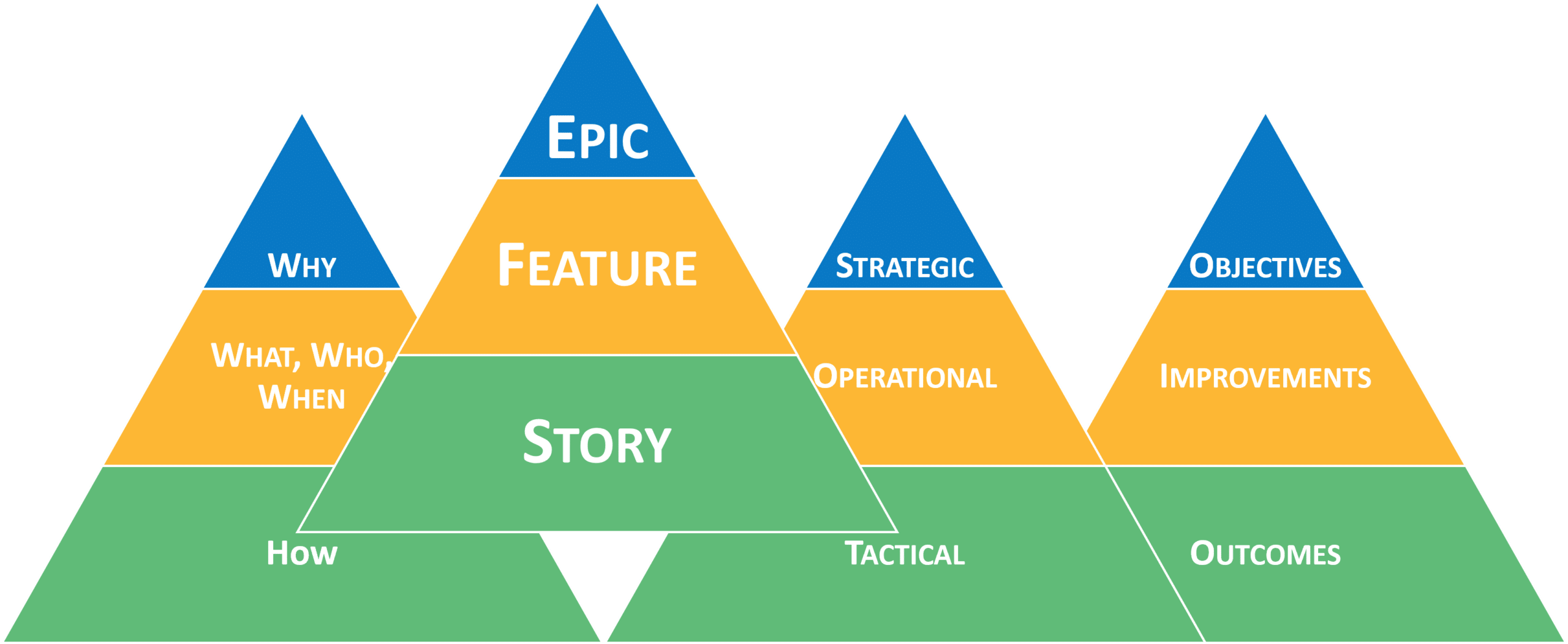The third of three (3 of 3) perspectives used to Organize Enterprise Content segments transformation scope from a Delivery Perspective. Importantly, each Business, IT, and/or Vendor participant in transformation delivery or package implementation must understand this perspective.
Previously, reviews of the higher-level segments used to organize Content looked at the:
Consequently, it is now possible to introduce these lower-level segments with some context.
The Delivery Perspective introduces the following Solution Delivery terms below:
- Epic
- Feature and
- Story.
Indeed, these objects have varying definitions across different companies and within various support tools. Of course, those definitions are not always compatible.
Accordingly, that is why the Iterative Transformation Model defines these terms here. To be sure, the model enforces a more prescriptive definition to facilitate alignment and consistency. Then again, while these definitions are more constrained, they are not inconsistent with the broader use of each object.

ITM Delivery Perspective
Within the ITM, use Epics, Features, and Stories have the following meanings.
Epic
An Epic describes some broad scope of functionality which, ultimately, aligns to a specific Business Segment. Moreover, Epics also define objectives.
Typically, from a Business Perspective, an Epic will relate to either a Process Group, a Business Process, or an Activity within a Process (an Activity is the first level of decomposition within a Process).
For instance, a process such as 'Sales Management' or 'Service Management' could have Epics of 'Sales' or 'Service'. Or, Activities within the Sales Management process, such as 'Manage Opportunities', 'Manage Quotes' and 'Manage Contracts' may have Epics of 'Opportunities', 'Quotes' or 'Contracts'.
Similarly, from a Technology Perspective, an Epic will typically describe either a Technology Group, a Technology Enabler, or a specific function within an Enabler. For example, Enablers such as 'Application Messaging', 'EDI' or 'Workflow' may have Epics of corresponding names. Alternatively, a more generic 'System Integrations' Epic may suffice.
From the Delivery Perspective, the ITM does not limit Epics to a single Process or technology Enabler. However, any such groups must roll up to a single owner in the corresponding Business Segment.
Feature
A Feature describes some increment of Business Value within a given Epic. In general, they describe what the Business wants (i.e., the ability to do...). To illustrate, Business Value means the organization can do something it wants to. Conversely, not having that ability means the value is missing.
Typically, each Feature should define just one function. For instance, things like 'Enter Quote', 'Update Quote', 'Process Quote' and 'Delete Quote' would be four samples of Features that would relate to a 'Manage Quotes' Epic.
Generally, there are three types of Features:
- Business Features - relate to Business Processes, Activities and Tasks.
- Architecture Features - relate to technology Enablers; and
- Tech Debt Features - relate to maintenance and operational needs.
With these three Feature types, organizations can manage all work required to create, update, operate and maintain any Solution.
Story
Whereas Features describe what functionality the business wants, from a Delivery Perspective, Stories describe how to enable that functionality.
For instance, consider the example Feature 'Enter Quote'. Perhaps the organization requires the following to enable this feature:
- a page upon which to enter information.
- a process to validate the data entered; and
- a report to generate output of the information entered.
These are three (3) separate Stories that describe how to deliver the one (1) Feature.
Of course, there is much more to Epics, Features, and Stories which appear throughout later ITM sections. However, for now it's only relevant to understand that these are the detailed objects used to deliver both Business and Technology transformation. For a preview of some additional delivery perspective information, see Solution Breakdowns.
To conclude, this part introduced both the high-level and low-level objects used to Organize Enterprise Content. Next, it's time to look at how these Content segments are organized and related to one another - by using Solutions.
